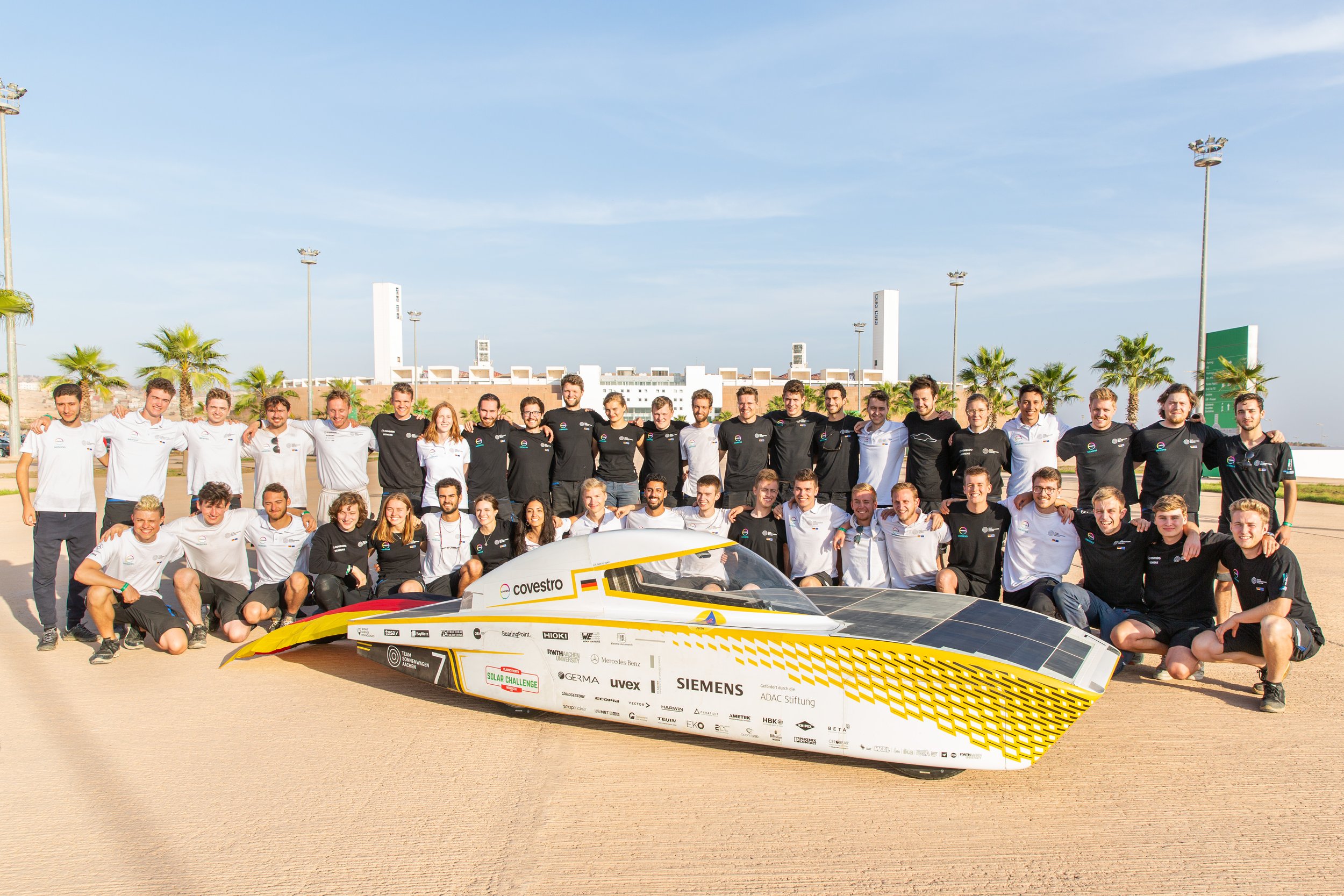
Covestro Photon
Three time’s the charm! Learning from its two successful predecessors, the Covestro Photon combines all their positive elements and adds many more. The solar car was finished in October after a difficult, covid shaped, season of working in small shifts and has been customized for the adventurous roads of Morocco.
2021
Build year
Mono-Si cells
Type of solar cells
6 kWh
Lithium iron phospate battery pack
120 km/h
Top Speed
4 m²
Area of the solar array
3
Number of wheels
190 kg
Total weight
25 %
Efficiency of the solar cells
Asymmetric steering
Steering
Achievements.
Solar Challenge Morocco 2021
5th place
Spirit of the Event Award
European Solar Challenge 2022
1st place
Italian Solar Challenge 2022
1st place

Download the fact sheet.
Technical highlights.
Electrical engineering
A large part of challenges in developing the Covestro Photon are in the field of electrical engineering. The basic goal of challenger class solar cars is to generate electric energy via a solar array. This is then temporarily stored in a battery before being converted into alternating current in an inverter and used in the electric motor to drive the solar car. Changes in regulations and the unique demands of the Solar Challenge Morocco 2021 presented the team with many new challenges in developing the Covestro Photon.
The gallium arsenide solar cells of the Covestro Sonnenwagen are no longer allowed, so the Covestro Photon uses high-efficiency monocrystalline silicon solar cells. This has increased the array size to 4 m² and the interconnection of the individual modules has been adapted to the much more variable irradiation in Morocco.
For the lithium-ion battery, we switched to lithium iron phosphate cell technology. Of this, 40kg are allowed, 20kg more than with the NMC cell technology. As a result, we have more than 1 kWh more energy available in the race. The battery is controlled by an adapted battery management system from Ecurie Aix (Formula Student Team of RWTH Aachen University). A small advantage of the LFP cell chemistry is that defective cells don’t incinerate, which is a significant safety gain.
However, the new battery cell technology brought with it the challenge of lower system voltage. This affects our electric motor in particular, because its power is determined by the product of current and voltage. To counter the power loss and still maintain the high efficiency of our electric powertrain, we used two inverters which run two separate coils in the same motor. With this configuration we have a high-torque mode and a high-speed mode. This allows us to efficiently master both flat passages through the desert and steep ones through the Atlas Mountains.
Kai Smit, Head of Electrical Engineering (2021)
The regulations allowed to only use three wheels this year. Implementing this aerodynamic win meant a lot of changes to the steering and suspension systems. Especially the asymmetric steering proved to be a big challenge.
Adrian Gruttke, Co-Head of the Mechanical department (2021)
Mechanical engineering
The mechanics team has taken up the challenge of building an innovative and competitive racing car for the world’s toughest solar race within just two years. For this purpose, we are divided into expert groups such as chassis, steering, brakes and structure in order to contribute to the development in the best possible way, depending on personal skills and experience.
All departments of Team Sonnenwagen Aachen are in constant and close contact with each other to ensure that all individual developments ultimately fit together in a coherent overall concept. In this way, technical questions can be clarified immediately, interfaces can be defined and innovative solutions can be developed. We are convinced: a team is more than the sum of its members!
Aerodynamics
In the beginning is the Aero. To be successful at the World Solar Challenge in Australia, an aerodynamic design is essential.
We develop the outer shell of our vehicle and are therefore largely responsible for the overall concept and are in close contact with the other departments.
Our goal is to develop a low-resistance, stable design for our solar car that is optimized for driving performance. We are convinced that our development work will produce a first-class design thanks to state-of-the-art CFD simulations, wind tunnel tests, intelligent system integration and continuous model optimization.
Jonas Padberg, Head of Aerodynamics (2021)
Tina Pauli, Head of Driving Strategy (2021)
Driving Strategy
This is where all information about the Sonnenwagen, the weather conditions and the course of the race comes together. Our strategists form the head of the team during the race. Using sophisticated algorithms and state-of-the-art measurement technology, they determine the optimum speed and steering angle of the Sonnenwagen.
The tasks include transmitting vehicle data, calculating the fastest and most energy-efficient speed and communicating with the driver and the rest of the team. In addition, this year the strategists are relying on their own weather and distance measurements as well as intelligent monitoring of the Sonnenwagen. In this way they are always one step ahead of the competition.












